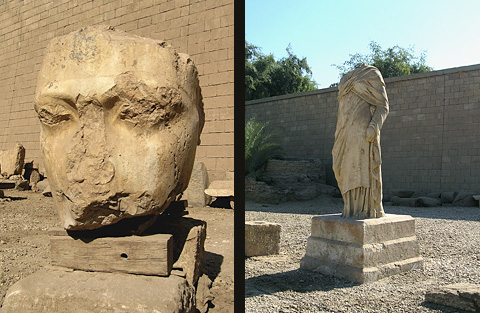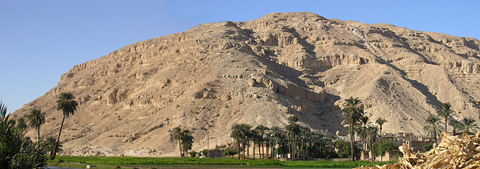Akhmim
The ancient town of Ipu was situated at Akmim, on the east bank of the Nile opposite the town of Sohag. In pharaonic times it was also known as Khent-Min, being the cult centre of the god Min. It is thought that Tiye, the mother of Akhenaten, had extensive estates in the area, which flourished as the capital of the 9th Upper Egyptian nome in the Ptolemaic Period, when it was known as Khemis. The Greeks knew the town as Panopolis, and the early Coptic Christians called it Chmin.

Many of the ancient buildings of Akhmim were dismantled to be used in later periods and today little exists in its original form. In 1981 however part of a temple with a monumental gate believed to date to the Graeco-Roman Period was unearthed during building works on the north-eastern edge of the town. Archaeologists found several statue fragments of Rameses II during excavations, as well as a beautiful colossal statue of the king’s daughter and consort, Meritamun, now re-erected in the centre of the area which has become an open-air museum, several metres below the modern ground level. The statue of Meritamun was a spectacular discovery, although when it was found lying face-down before the temple gateway, it was broken. Carved from limestone and now restored, the queen who stands 11m tall, wears a close-fitting pleated robe and is crowned with a modius (head-dress), decorated with serpents and the double-feathers of the ‘God’s Wife of Amun’. The museum also contains a beautiful Roman statue of Venus (Isis) as well as many stelae and architectural elements form the surrounding structures. There are also some large inscribed blocks from el-Amarna which were probably re-used in the later temple building.

The Graeco-Roman temple was dedicated to Min and Triphis (Repyt), the goddess who was his consort at Akhmim. Apparently the large temple, which was described as similar in style to the Temple of Edfu, was still in good repair until the 14th century, when it was dismantled to be used as building material. Beautifully decorated stonework and two colossal statues in the temple of Min were mentioned by Herodotus in his ‘Histories’.

More recent excavations in the town have uncovered yet another temple, close to the Graeco-Roman site, beneath a modern cemetery. This is a temple built by Rameses II , possibly his largest temple yet found. A ruined colossal statue of Rameses II (probably one of a pair) lies partly buried at what is thought to be the entrance of a temple once known as ‘The Birba’ which is referred to in Coptic and Arabic literature. The Egyptian government has agreed to allocate EGP 5 million in order to begin proper excavation of the site, relocating the old Muslim cemetery which partly covers the area and the construction of a new one.
The necropolis at Akhmim has never been systematically excavated, although recent discoveries include five tombs dating to the Old Kingdom where a number of sarcophagi and plaques have been found.
The modern town of Akhmim is also famous for its fine weaving and tapestries – one of Egypt’s oldest industries. There are several shops close to the open-air museum which demonstrate the craft and sell the beautiful Akhmim textiles.
Nearby monuments
To the north-east of Akhmim there are decorated rock-cut tombs at el-Hawawish, also known as Beit el-Medina, spanning the periods from late Dynasty VI to early Dynasty XII. They were first investigated by Percy Newberry in 1912 and belong to officials of the town and Middle Kingdom nomarchs of the Panopolite nome. During the 1990s more recent excavations have been undertaken by the Australian Centre for Egyptology Studies, directed by Naguib Kanawati.

At el-Salamuni, to the north-west of Akhmim, there are Graeco-Roman rock-cut tombs in the high cliffs, some of which are decorated with zodiac ceilings. There is also a small New Kingdom rock-cut chapel dedicated to Min, and decorated by Nakhmin, who held the title of ‘First Priest of Min’ during the reign of Ay (Dynasty XVIII). Reliefs depict Tuthmose III (Dynasty XVIII) as well as Ay and his wife Teye before local gods. The shrine was later restored with added decoration by Harma’kheru, another ‘First Priest of Min’ during the reign of Ptolemy II Philadelphus.
There are also ancient cemeteries to the north of Akhmim at Nag el-Kilabat and el-Sawama.
How to get there
Akhmim is on the opposite side of the river from Sohag, across the bridge. Visitors are currently escorted by the tourist police.
